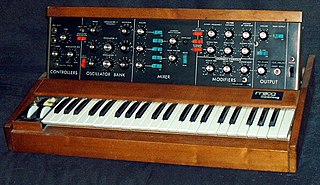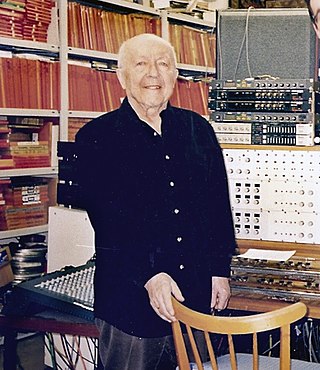Related Research Articles
Computer music is the application of computing technology in music composition, to help human composers create new music or to have computers independently create music, such as with algorithmic composition programs. It includes the theory and application of new and existing computer software technologies and basic aspects of music, such as sound synthesis, digital signal processing, sound design, sonic diffusion, acoustics, electrical engineering, and psychoacoustics. The field of computer music can trace its roots back to the origins of electronic music, and the first experiments and innovations with electronic instruments at the turn of the 20th century.
Electronic music broadly is a group of music genres that employ electronic musical instruments, circuitry-based music technology and software, or general-purpose electronics in its creation. It includes both music made using electronic and electromechanical means. Pure electronic instruments depended entirely on circuitry-based sound generation, for instance using devices such as an electronic oscillator, theremin, or synthesizer. Electromechanical instruments can have mechanical parts such as strings, hammers, and electric elements including magnetic pickups, power amplifiers and loudspeakers. Such electromechanical devices include the telharmonium, Hammond organ, electric piano and electric guitar.

An electronic musical instrument or electrophone is a musical instrument that produces sound using electronic circuitry. Such an instrument sounds by outputting an electrical, electronic or digital audio signal that ultimately is plugged into a power amplifier which drives a loudspeaker, creating the sound heard by the performer and listener.

Raymond Kurzweil is an American computer scientist, author, inventor, and futurist. He is involved in fields such as optical character recognition (OCR), text-to-speech synthesis, speech recognition technology and electronic keyboard instruments. He has written books on health technology, artificial intelligence (AI), transhumanism, the technological singularity, and futurism. Kurzweil is a public advocate for the futurist and transhumanist movements and gives public talks to share his optimistic outlook on life extension technologies and the future of nanotechnology, robotics, and biotechnology.

Digital music technology encompasses the use of digital instruments, computers, electronic effects units, software, or digital audio equipment by a performer, composer, sound engineer, DJ, or record producer to produce, perform or record music. The term refers to electronic devices, instruments, computer hardware, and software used in performance, playback, recording, composition, mixing, analysis, and editing of music.
Outsider music is music created by self-taught or naïve musicians. The term is usually applied to musicians who have little or no traditional musical experience, who exhibit childlike qualities in their music, or who have intellectual disabilities or mental illnesses. The term was popularized in the 1990s by journalist and WFMU DJ Irwin Chusid.
A music sequencer is a device or application software that can record, edit, or play back music, by handling note and performance information in several forms, typically CV/Gate, MIDI, or Open Sound Control, and possibly audio and automation data for digital audio workstations (DAWs) and plug-ins.

Raymond Scott was an American composer, band leader, pianist, record producer, and inventor of electronic instruments.

An analog synthesizer is a synthesizer that uses analog circuits and analog signals to generate sound electronically.
Motown is an American record label owned by the Universal Music Group. It was founded by Berry Gordy Jr. as Tamla Records on January 12, 1959, and incorporated as Motown Record Corporation on April 14, 1960. Its name, a portmanteau of motor and town, has become a nickname for Detroit, where the label was originally headquartered.
Bruce Clinton Haack was a Canadian musician and composer in the field of electronic music.

Oskar Sala was a German composer and a pioneer of electronic music. He played an instrument called the Trautonium, an early form of electronic synthesizer.
Irwin Chusid is a journalist, music historian, radio personality, record producer, and self-described "landmark preservationist". His stated mission has been to "find things on the scrapheap of history that I know don't belong there and salvage them." Those "things" have included such previously overlooked but now-celebrated icons as composer/bandleader/electronic music pioneer Raymond Scott, Space Age Pop avatar Esquivel, illustrator/fine artist Jim Flora, various outsider musicians, and The Langley Schools Music Project. Chusid calls himself "a connoisseur of marginalia," while admitting he's "a terrible barometer of popular taste."
Brian Kehew is an American musician and record producer. He is a member of The Moog Cookbook and co-author of the Recording The Beatles book, an in-depth look at the Beatles' studio approach.

James Royer Flora was an American artist best known for his distinctive and idiosyncratic album cover art for RCA Victor and Columbia Records during the 1940s and 1950s. He was also a prolific commercial illustrator from the 1940s to the 1970s and the author/illustrator of 17 popular children's books. He was a fine artist as well, who created hundreds of paintings, drawings, etchings and sketches over his 84-year life.
The Clavivox was a keyboard sound synthesizer and sequencer developed by American composer Raymond Scott.

Brian Carpenter is an American musician, songwriter, composer, arranger, producer, and radio host. He is the lead singer and songwriter for the Boston, Massachusetts band Beat Circus. In 2011, he formed Brian Carpenter & The Confessions and released its debut album in 2015. He is also a founder and musical director of Ghost Train Orchestra in Brooklyn.

Manhattan Research, Inc. is a two-CD compilation of electronic music created by the musician, composer and inventor, Raymond Scott and his company, "Manhattan Research Inc." Posthumously released in 2000 by Basta Music of the Netherlands, the album contains selected samples of Scott's work from the 1950s and 1960s for film soundtracks, commercials, and for his own technical and musical experiments. The synthesizers, sequencers, and drum-machines used were designed and constructed by Raymond Scott.

Malcolm Cecil was a British jazz bassist, record producer, engineer, electronic musician and teacher. He was a founding member of a leading UK jazz quintet of the late 1950s, the Jazz Couriers, before going on to join a number of British jazz combos led by Dick Morrissey, Tony Crombie and Ronnie Scott in the late 1950s and early 1960s. He later joined Cyril Davies and Alexis Korner to form the original line-up of Blues Incorporated. Cecil subsequently collaborated with Robert Margouleff to form the duo TONTO's Expanding Head Band, a project based on a unique combination of synthesizers which led to them collaborating on and co-producing several of Stevie Wonder's Grammy-winning albums of the early 1970s. The TONTO synthesizer was described by Rolling Stone as "revolutionary".

Soothing Sounds for Baby (1962) is a three-volume set of ambient electronic music by American composer, musician, and inventor Raymond Scott. Scott originally intended to lull infants to sleep with the music, but later generations have found value in the music for its minimalist aspects, often comparing it to the works of Brian Eno, Kraftwerk and Tangerine Dream despite having predated such artists by more than a decade.
References
- ↑ Raymond Scott Artifacts
- 1 2 3 4 5 6 Chusid, Irwin Beethoven-in-a-box: Raymond Scott's electronium. Contemporary Music Review,18(3):9-14 1999.
- 1 2 3 Stanley Warnow (2010). "Deconstructing Dad" documentary DVD, http://scottdoc.com/.
- ↑ Chusid, Irwin (2000). Album notes for Manhattan Research Inc. by Raymond Scott, p. 80 [CD book]. Holland: Basta Audio/Visuals.
- ↑ "Can Synthesizers Compose Music? Nearly 50 Years Ago, This One Could". LA Weekly, June 20, 2017. Retrieved 2021-01-24.